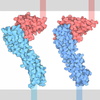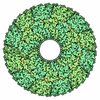+ Open data
Open data
- Basic information
Basic information
| Entry | Database: PDB / ID: 5vl3 | ||||||||||||
|---|---|---|---|---|---|---|---|---|---|---|---|---|---|
| Title | CD22 d1-d3 in complex with therapeutic Fab Epratuzumab | ||||||||||||
 Components Components |
| ||||||||||||
 Keywords Keywords | IMMUNE SYSTEM / therapeutic antibody / Siglec / B cell / Fab | ||||||||||||
| Function / homology |  Function and homology information Function and homology informationregulation of B cell proliferation / IgM binding / negative regulation of immunoglobulin production / negative regulation of B cell receptor signaling pathway / sialic acid binding / CD22 mediated BCR regulation / negative regulation of calcium-mediated signaling / CD4 receptor binding / neuronal cell body membrane / regulation of endocytosis ...regulation of B cell proliferation / IgM binding / negative regulation of immunoglobulin production / negative regulation of B cell receptor signaling pathway / sialic acid binding / CD22 mediated BCR regulation / negative regulation of calcium-mediated signaling / CD4 receptor binding / neuronal cell body membrane / regulation of endocytosis / B cell activation / immunoglobulin complex / regulation of immune response / Antigen activates B Cell Receptor (BCR) leading to generation of second messengers / recycling endosome / Immunoregulatory interactions between a Lymphoid and a non-Lymphoid cell / carbohydrate binding / protein phosphatase binding / adaptive immune response / early endosome / cell adhesion / signaling receptor binding / external side of plasma membrane / cell surface / extracellular exosome / extracellular region / metal ion binding / membrane / plasma membrane / cytoplasm Similarity search - Function | ||||||||||||
| Biological species |  Homo sapiens (human) Homo sapiens (human) | ||||||||||||
| Method |  X-RAY DIFFRACTION / X-RAY DIFFRACTION /  SYNCHROTRON / SYNCHROTRON /  MOLECULAR REPLACEMENT / Resolution: 3.1 Å MOLECULAR REPLACEMENT / Resolution: 3.1 Å | ||||||||||||
 Authors Authors | Sicard, T. / Ereno-Orbea, J. / Julien, J.P. | ||||||||||||
| Funding support |  Canada, 3items Canada, 3items
| ||||||||||||
 Citation Citation |  Journal: Nat Commun / Year: 2017 Journal: Nat Commun / Year: 2017Title: Molecular basis of human CD22 function and therapeutic targeting. Authors: June Ereño-Orbea / Taylor Sicard / Hong Cui / Mohammad T Mazhab-Jafari / Samir Benlekbir / Alba Guarné / John L Rubinstein / Jean-Philippe Julien /  Abstract: CD22 maintains a baseline level of B-cell inhibition to keep humoral immunity in check. As a B-cell-restricted antigen, CD22 is targeted in therapies against dysregulated B cells that cause ...CD22 maintains a baseline level of B-cell inhibition to keep humoral immunity in check. As a B-cell-restricted antigen, CD22 is targeted in therapies against dysregulated B cells that cause autoimmune diseases and blood cancers. Here we report the crystal structure of human CD22 at 2.1 Å resolution, which reveals that specificity for α2-6 sialic acid ligands is dictated by a pre-formed β-hairpin as a unique mode of recognition across sialic acid-binding immunoglobulin-type lectins. The CD22 ectodomain adopts an extended conformation that facilitates concomitant CD22 nanocluster formation on B cells and binding to trans ligands to avert autoimmunity in mammals. We structurally delineate the CD22 site targeted by the therapeutic antibody epratuzumab at 3.1 Å resolution and determine a critical role for CD22 N-linked glycosylation in antibody engagement. Our studies provide molecular insights into mechanisms governing B-cell inhibition and valuable clues for the design of immune modulators in B-cell dysfunction.The B-cell-specific co-receptor CD22 is a therapeutic target for depleting dysregulated B cells. Here the authors structurally characterize the ectodomain of CD22 and present its crystal structure with the bound therapeutic antibody epratuzumab, which gives insights into the mechanism of inhibition of B-cell activation. | ||||||||||||
| History |
|
- Structure visualization
Structure visualization
| Structure viewer | Molecule:  Molmil Molmil Jmol/JSmol Jmol/JSmol |
|---|
- Downloads & links
Downloads & links
- Download
Download
| PDBx/mmCIF format |  5vl3.cif.gz 5vl3.cif.gz | 1.1 MB | Display |  PDBx/mmCIF format PDBx/mmCIF format |
|---|---|---|---|---|
| PDB format |  pdb5vl3.ent.gz pdb5vl3.ent.gz | 949.6 KB | Display |  PDB format PDB format |
| PDBx/mmJSON format |  5vl3.json.gz 5vl3.json.gz | Tree view |  PDBx/mmJSON format PDBx/mmJSON format | |
| Others |  Other downloads Other downloads |
-Validation report
| Summary document |  5vl3_validation.pdf.gz 5vl3_validation.pdf.gz | 1.1 MB | Display |  wwPDB validaton report wwPDB validaton report |
|---|---|---|---|---|
| Full document |  5vl3_full_validation.pdf.gz 5vl3_full_validation.pdf.gz | 1.1 MB | Display | |
| Data in XML |  5vl3_validation.xml.gz 5vl3_validation.xml.gz | 110.5 KB | Display | |
| Data in CIF |  5vl3_validation.cif.gz 5vl3_validation.cif.gz | 139.7 KB | Display | |
| Arichive directory |  https://data.pdbj.org/pub/pdb/validation_reports/vl/5vl3 https://data.pdbj.org/pub/pdb/validation_reports/vl/5vl3 ftp://data.pdbj.org/pub/pdb/validation_reports/vl/5vl3 ftp://data.pdbj.org/pub/pdb/validation_reports/vl/5vl3 | HTTPS FTP |
-Related structure data
| Related structure data |  8704C  8705C  5vkjC 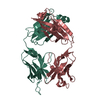 5vkkC  5vkmC C: citing same article ( |
|---|---|
| Similar structure data | |
| Other databases |
|
- Links
Links
- Assembly
Assembly
| Deposited unit | 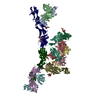
| ||||||||
|---|---|---|---|---|---|---|---|---|---|
| 1 | 
| ||||||||
| 2 | 
| ||||||||
| 3 | 
| ||||||||
| 4 | 
| ||||||||
| Unit cell |
|
- Components
Components
-Antibody , 2 types, 8 molecules ACEHBDFL
| #2: Antibody | Mass: 24028.684 Da / Num. of mol.: 4 Source method: isolated from a genetically manipulated source Source: (gene. exp.)   Homo sapiens (human) Homo sapiens (human)Production host:  Homo sapiens (human) / References: UniProt: S6B291 Homo sapiens (human) / References: UniProt: S6B291#3: Antibody | Mass: 24340.979 Da / Num. of mol.: 4 Source method: isolated from a genetically manipulated source Source: (gene. exp.)   Homo sapiens (human) Homo sapiens (human)Production host:  Homo sapiens (human) / References: UniProt: Q8TCD0 Homo sapiens (human) / References: UniProt: Q8TCD0 |
|---|
-Protein / Non-polymers , 2 types, 5 molecules QRST

| #1: Protein | Mass: 36802.406 Da / Num. of mol.: 4 Source method: isolated from a genetically manipulated source Source: (gene. exp.)  Homo sapiens (human) / Gene: CD22, SIGLEC2 / Production host: Homo sapiens (human) / Gene: CD22, SIGLEC2 / Production host:  Homo sapiens (human) / References: UniProt: P20273 Homo sapiens (human) / References: UniProt: P20273#8: Chemical | ChemComp-GOL / | |
|---|
-Sugars , 4 types, 8 molecules
| #4: Polysaccharide | 2-acetamido-2-deoxy-beta-D-glucopyranose-(1-4)-2-acetamido-2-deoxy-beta-D-glucopyranose Source method: isolated from a genetically manipulated source #5: Polysaccharide | alpha-D-mannopyranose-(1-3)-[alpha-D-mannopyranose-(1-6)]beta-D-mannopyranose-(1-4)-2-acetamido-2- ...alpha-D-mannopyranose-(1-3)-[alpha-D-mannopyranose-(1-6)]beta-D-mannopyranose-(1-4)-2-acetamido-2-deoxy-beta-D-glucopyranose-(1-4)-2-acetamido-2-deoxy-beta-D-glucopyranose | Source method: isolated from a genetically manipulated source #6: Polysaccharide | Source method: isolated from a genetically manipulated source #7: Polysaccharide | beta-D-mannopyranose-(1-4)-2-acetamido-2-deoxy-beta-D-glucopyranose-(1-4)-2-acetamido-2-deoxy-beta- ...beta-D-mannopyranose-(1-4)-2-acetamido-2-deoxy-beta-D-glucopyranose-(1-4)-2-acetamido-2-deoxy-beta-D-glucopyranose | Source method: isolated from a genetically manipulated source |
|---|
-Details
| Has protein modification | Y |
|---|
-Experimental details
-Experiment
| Experiment | Method:  X-RAY DIFFRACTION / Number of used crystals: 1 X-RAY DIFFRACTION / Number of used crystals: 1 |
|---|
- Sample preparation
Sample preparation
| Crystal | Density Matthews: 2.99 Å3/Da / Density % sol: 58.84 % |
|---|---|
| Crystal grow | Temperature: 293 K / Method: vapor diffusion / Details: 20 mM Tris pH 8.0 and 150 mM NaCl, 5mg/mL |
-Data collection
| Diffraction | Mean temperature: 100 K |
|---|---|
| Diffraction source | Source:  SYNCHROTRON / Site: SYNCHROTRON / Site:  CLSI CLSI  / Beamline: 08ID-1 / Wavelength: 0.97949 Å / Beamline: 08ID-1 / Wavelength: 0.97949 Å |
| Detector | Type: RAYONIX MX-300 / Detector: CCD / Date: Dec 1, 2016 |
| Radiation | Protocol: SINGLE WAVELENGTH / Monochromatic (M) / Laue (L): M / Scattering type: x-ray |
| Radiation wavelength | Wavelength: 0.97949 Å / Relative weight: 1 |
| Reflection | Resolution: 3.1→39.345 Å / Num. obs: 65863 / % possible obs: 94.2 % / Redundancy: 1.9 % / Biso Wilson estimate: 65.68 Å2 / CC1/2: 0.987 / Rmerge(I) obs: 0.09 / Rpim(I) all: 0.09 / Net I/σ(I): 8.2 |
| Reflection shell | Resolution: 3.1→3.2 Å / Redundancy: 1.9 % / Rmerge(I) obs: 0.39 / Mean I/σ(I) obs: 1.9 / CC1/2: 0.74 / Rpim(I) all: 0.39 / % possible all: 96.7 |
- Processing
Processing
| Software |
| |||||||||||||||||||||||||||||||||||||||||||||||||||||||||||||||||||||||||||||||||||||||||||||||||||||||||
|---|---|---|---|---|---|---|---|---|---|---|---|---|---|---|---|---|---|---|---|---|---|---|---|---|---|---|---|---|---|---|---|---|---|---|---|---|---|---|---|---|---|---|---|---|---|---|---|---|---|---|---|---|---|---|---|---|---|---|---|---|---|---|---|---|---|---|---|---|---|---|---|---|---|---|---|---|---|---|---|---|---|---|---|---|---|---|---|---|---|---|---|---|---|---|---|---|---|---|---|---|---|---|---|---|---|---|
| Refinement | Method to determine structure:  MOLECULAR REPLACEMENT / Resolution: 3.1→39.345 Å / SU ML: 0.43 / Cross valid method: FREE R-VALUE / σ(F): 1.96 / Phase error: 32.03 / Stereochemistry target values: ML MOLECULAR REPLACEMENT / Resolution: 3.1→39.345 Å / SU ML: 0.43 / Cross valid method: FREE R-VALUE / σ(F): 1.96 / Phase error: 32.03 / Stereochemistry target values: ML
| |||||||||||||||||||||||||||||||||||||||||||||||||||||||||||||||||||||||||||||||||||||||||||||||||||||||||
| Solvent computation | Shrinkage radii: 0.9 Å / VDW probe radii: 1.11 Å / Solvent model: FLAT BULK SOLVENT MODEL | |||||||||||||||||||||||||||||||||||||||||||||||||||||||||||||||||||||||||||||||||||||||||||||||||||||||||
| Refinement step | Cycle: LAST / Resolution: 3.1→39.345 Å
| |||||||||||||||||||||||||||||||||||||||||||||||||||||||||||||||||||||||||||||||||||||||||||||||||||||||||
| Refine LS restraints |
| |||||||||||||||||||||||||||||||||||||||||||||||||||||||||||||||||||||||||||||||||||||||||||||||||||||||||
| LS refinement shell |
|
 Movie
Movie Controller
Controller






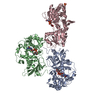
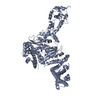


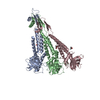
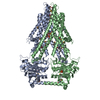

 PDBj
PDBj

